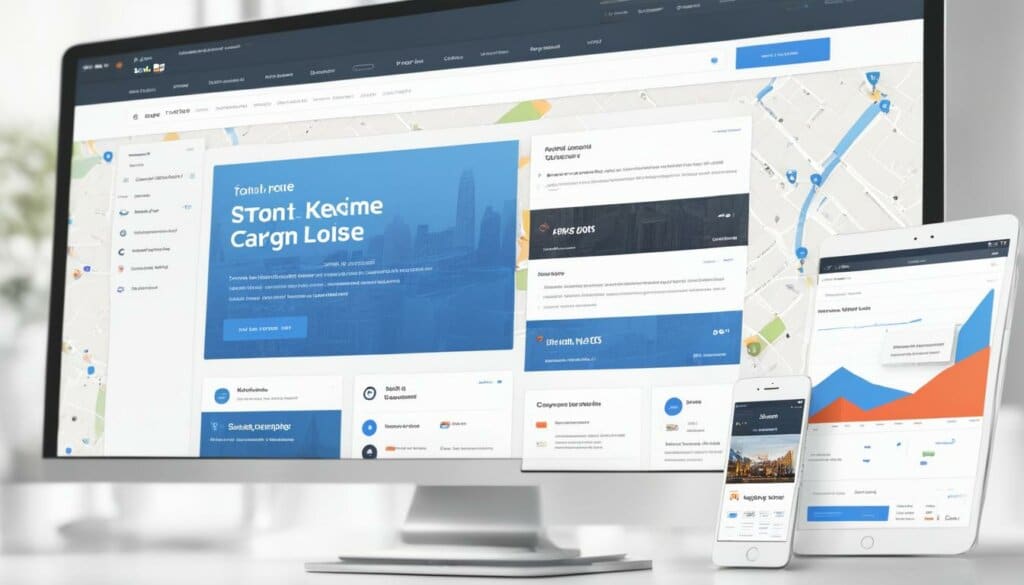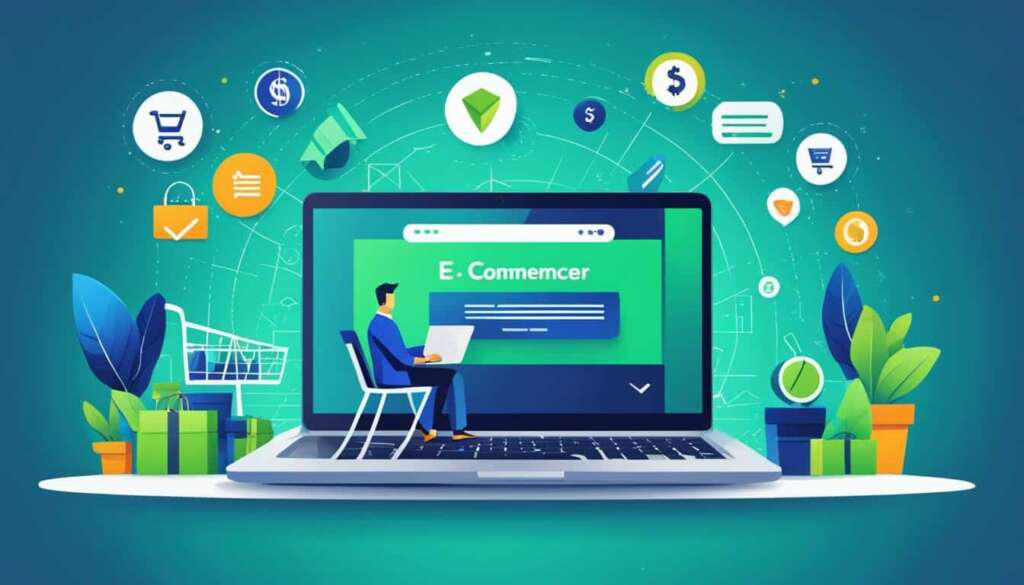Table of Contents
Starting an e-commerce business can be daunting, but with the right guidance, you can successfully set up your online store and start an ecommerce store. In this article, we will guide you through each step of the process, from finding product opportunities to launching your business.
When it comes to building an online business, there are many factors to consider. From product research to website design, every step plays a crucial role in your success. By understanding the key elements of setting up an e-commerce store, you can pave the way for profitability and growth.
Whether you’re an aspiring entrepreneur or an established business looking to expand online, this article will provide you with the knowledge and tools you need to build an online business. So let’s dive in and explore the exciting world of e-commerce!
Find Product Opportunities and Choose What to Sell
The first step in setting up your e-commerce business is finding product opportunities and choosing what to sell. This crucial stage requires careful research and analysis to ensure you offer products with high market potential. By conducting thorough product research, you can make informed decisions that maximize your chances of success.
Identifying Product Opportunities
Researching competition and analyzing market trends are essential strategies for identifying product opportunities. By studying your competitors, you can gain valuable insights into what products are in-demand and uncover gaps in the market. Additionally, monitoring market trends allows you to stay in tune with consumer preferences and adapt your product offerings accordingly.
“Researching competition and analyzing market trends are essential strategies for identifying product opportunities.”
Furthermore, consider conducting keyword research to understand the search volume and competition level for specific products. This will help you gauge the demand and establish which products have the potential to generate significant sales. Keyword research tools such as Google Keyword Planner and SEMrush can provide valuable data and insights to guide your decision-making process.
Choosing What to Sell
Once you have identified potential product opportunities, the next step is to choose what to sell. It’s important to focus on products that align with your target audience’s needs and preferences. Consider factors such as product quality, uniqueness, and perceived value when making your selection.
Additionally, evaluate the profitability of each product by considering its production or acquisition costs, potential profit margins, and shipping requirements. Conducting a thorough cost analysis will ensure that you choose products that offer a healthy return on investment.
Furthermore, it’s important to assess the market saturation and competition level for each product. Avoid entering overcrowded markets unless you can offer a unique selling proposition or find a niche audience that is underserved. Researching your competition and understanding their strengths and weaknesses can help you position your products effectively and differentiate yourself in the market.
By carefully assessing product opportunities and choosing what to sell strategically, you can set your e-commerce business up for success.
| Key Steps in Finding Product Opportunities and Choosing What to Sell | Description |
|---|---|
| Research competition | Study your competitors to identify gaps in the market and gain insights into in-demand products. |
| Analyze market trends | Stay informed about changing consumer preferences and adapt your product offerings accordingly. |
| Conduct keyword research | Identify popular search terms related to your potential products to gauge demand and competition. |
| Consider target audience preferences | Choose products that align with your target audience’s needs, preferences, and values. |
| Evaluate product profitability | Assess production or acquisition costs, profit margins, and shipping requirements to ensure profitability. |
| Assess market saturation and competition | Avoid overcrowded markets and find ways to differentiate your products effectively. |
By following these key steps, you can identify product opportunities with excellent business potential and choose the right products to sell in your e-commerce store.
Obtain Your Products
Once you have identified the products you want to sell, the next step is obtaining them. There are various methods for sourcing products, including dropshipping and print-on-demand. Understanding different product sourcing models will help you choose the best approach for your business.
Dropshipping: Convenient and Low-Risk

Dropshipping is a popular method for obtaining products as it offers convenience and low-risk for e-commerce businesses. With dropshipping, you partner with suppliers who handle inventory and shipping. Here’s how it works:
- You set up your online store and list products that you want to sell.
- When a customer places an order on your website, you forward the order details to the supplier.
- The supplier then processes and ships the order directly to the customer on your behalf.
With dropshipping, you don’t need to worry about inventory management or shipping logistics. This allows you to focus on marketing and growing your business without the hassle of handling physical products.
Print-on-Demand: Customizable and Scalable

If you’re interested in selling unique, customized products, print-on-demand can be a great sourcing option. Here’s how it works:
- You partner with a print-on-demand company that specializes in printing and shipping customized products.
- You create designs or artworks that will be printed on various products such as t-shirts, mugs, or phone cases.
- When a customer places an order on your online store, the print-on-demand company receives the order and prints the design on the selected product.
- The customized product is then shipped directly to the customer.
Print-on-demand allows you to offer unique, personalized products without the need for upfront inventory investment. It’s a scalable model that allows you to expand your product offerings as your business grows.
When choosing your product sourcing method, consider factors such as your budget, target audience, and the nature of your products. Dropshipping and print-on-demand offer distinct advantages, and choosing the right model will contribute to the success of your e-commerce business.
Set Up Your Online Store
After obtaining your products, it’s time to set up your online store. This step is crucial as it lays the foundation for your e-commerce business. By choosing an e-commerce website builder, you can simplify the process and save time.
“A website builder is an excellent tool for entrepreneurs looking to start their online store. It provides an intuitive platform with pre-designed templates and user-friendly tools to help you build a professional website without any coding knowledge.” – Sarah Johnson, E-commerce Expert
One popular website builder to consider is Shopify. Shopify offers a range of customizable templates and features that cater to various industries. It allows you to showcase your products effectively and facilitate seamless transactions.
Website Design
When setting up your online store, website design plays a crucial role in attracting customers and encouraging conversions. Consider the following elements:
- Logo: Choose a memorable logo that represents your brand identity. It should be visually appealing and easy to recognize.
- Theme: Customize your website theme to align with your brand’s colors, style, and target audience. A consistent and visually pleasing theme creates a cohesive and professional online shopping experience.
- Navigation: Ensure your website is easy to navigate, with clear menu options and categories. A well-organized navigation structure allows visitors to find products quickly.
- Product Display: Present your products with high-quality images and detailed descriptions. Include multiple product views, zoom features, and customer reviews to enhance the shopping experience.
Search Engine Optimization (SEO)
Understanding search engine optimization (SEO) is essential for improving your online store’s visibility on search engines like Google. By optimizing your website, you can attract organic traffic and increase your chances of reaching potential customers.
“Implementing SEO best practices is crucial for e-commerce businesses. It helps improve your website’s ranking, making it more visible to your target audience. With effective SEO strategies, you can optimize your product pages and drive organic traffic, resulting in higher conversions.” – Mark Thompson, SEO Specialist
Here are some SEO tips to consider:
- Keyword Research: Identify relevant keywords related to your products and target audience. Incorporate these keywords into your product titles, descriptions, and URLs.
- URL Structure: Optimize your URL structure by using descriptive, keyword-rich URLs for each product page.
- Page Titles and Meta Descriptions: Craft compelling and relevant page titles and meta descriptions that entice users to click on your website in search results.
- Image Optimization: Optimize your product images by using descriptive file names and adding alt tags that include relevant keywords.
- Mobile-Friendly Website: Ensure your website is mobile-friendly, as mobile optimization is a crucial factor in improving search rankings.
To achieve optimal SEO results, it’s recommended to conduct regular keyword research, monitor website analytics, and make necessary adjustments to your SEO strategy.
By setting up your online store with a website builder, designing an attractive website, and implementing SEO strategies, you’ll be well on your way to creating a successful e-commerce business.

| Pros of using a website builder for your online store | Cons of using a website builder for your online store |
|---|---|
| 1. Easy to use and beginner-friendly | 1. Limited customization options |
| 2. Provides pre-designed templates for quick setup | 2. May require additional expenses for advanced features |
| 3. Offers integrated e-commerce features and payment gateways | 3. May have limitations on product variations and inventory management |
| 4. Regular updates and customer support | 4. Less flexibility compared to custom-built websites |
| 5. Cost-effective solution for small businesses | 5. May have limited SEO capabilities |
Research Your Competition and Write a Business Plan
When venturing into the competitive e-commerce market, it is essential to conduct thorough research on your competition. By analyzing their strategies and identifying their unique selling points, you can gain valuable insights that will help differentiate your business and give you a competitive edge. To succeed in this fast-paced digital landscape, it is crucial to stay one step ahead of your rivals.
“In the business world, everyone is paid in two coins: cash and experience. Take the experience first; the cash will come later.” – Harold Geneen
Competitive analysis allows you to understand the strengths and weaknesses of your competitors, their pricing strategies, product offerings, and customer engagement techniques. By identifying the gaps in the market, you can position your business to meet the needs of your target audience effectively.
Additionally, writing a comprehensive business plan is a critical step in establishing a successful e-commerce venture. Your business plan serves as a roadmap, outlining your goals, target market, marketing strategies, and financial projections. It helps you define your business’s unique value proposition and guides your decision-making process as you navigate through the competitive landscape.
During the process of writing your business plan, consider the following key elements:
1. Executive Summary
This section provides an overview of your business, highlighting your vision, mission, and the core values that will drive your success.
2. Market Analysis
Conduct thorough market research to gain a deep understanding of your industry, target market, and customer demographics. Identify key trends, opportunities, and challenges that may impact your business, and use this information to formulate effective strategies.
3. Competitive Analysis
Detail the results of your research into your competition, including their strengths and weaknesses, market position, and unique selling propositions. This analysis will help you identify opportunities to differentiate your business and capture market share.
4. Marketing and Sales Strategies
Outline your marketing and sales plans, including your brand positioning, promotion strategies, pricing strategies, and distribution channels. Consider the most effective ways to reach your target audience and convert leads into customers.
5. Operational Plans
Explain the logistics of running your e-commerce business, including inventory management, order fulfillment, customer service, and any other operational considerations. Ensure you have scalable systems and processes in place to handle growth.
6. Financial Projections
Provide detailed financial projections, including revenue forecasts, expense budgets, cash flow projections, and return on investment estimates. Use this information to evaluate the feasibility and profitability of your e-commerce venture.
By thoroughly researching your competition and writing a comprehensive business plan, you will be well-equipped to navigate the competitive e-commerce landscape strategically. These essential steps will set you on a path to success, ensuring that your business stands out and thrives in the digital marketplace.
Choose Your Shipping Strategy and Set Sales and Marketing Goals
As you prepare to launch your e-commerce business, it is crucial to carefully consider your shipping strategy and set clear sales and marketing goals. These two components are vital for the success of your online store, as they directly impact customer satisfaction, order fulfillment, and overall business growth.
Shipping Strategy:
Choosing the right shipping strategy is essential to ensure a seamless customer experience and efficient order fulfillment. Start by evaluating various delivery options, such as partnering with reliable shipping carriers or utilizing fulfillment services. Consider factors like shipping costs, delivery time, and tracking capabilities to select the best shipping methods for your business.
Sales and Marketing Goals:
Setting sales and marketing goals is crucial for tracking your e-commerce business’s progress and planning for future growth. By defining measurable objectives, you can evaluate your sales performance and identify areas for improvement. Consider metrics such as revenue targets, customer acquisition rates, conversion rates, and return on investment (ROI).
“Setting measurable sales and marketing goals will help you track your business’s success and plan for growth.”
When setting sales goals, consider both short-term and long-term objectives. Short-term goals may involve increasing daily sales or reaching a specific revenue target within a certain timeframe. Long-term goals could include expanding into new markets, launching product lines, or achieving a specific market share.
Marketing goals should focus on increasing brand visibility, driving website traffic, and converting visitors into paying customers. Consider implementing various marketing tactics such as search engine optimization (SEO), social media marketing, content marketing, email marketing, and influencer collaborations.
Key Takeaways:
- Choose a shipping strategy that prioritizes customer satisfaction and efficient order fulfillment.
- Set clear and measurable sales goals to track your business’s progress and identify areas for improvement.
- Define marketing goals that focus on increasing brand visibility, driving website traffic, and converting visitors into customers.
The Importance of Shipping Strategy and Sales & Marketing Goals
Your shipping strategy directly impacts customer satisfaction and can significantly influence whether shoppers choose to purchase from your online store. By offering reliable and affordable shipping options, you can build trust with your customers, enhance their overall shopping experience, and increase the likelihood of repeat purchases.
Additionally, setting sales and marketing goals provides your business with a clear direction and objectives to strive towards. It helps you stay focused on your business’s growth and profitability while also guiding your marketing efforts to maximize their impact. With well-defined goals, you can allocate resources effectively, measure your performance, and make data-driven decisions to achieve success in the competitive e-commerce landscape.
| Benefits of Choosing the Right Shipping Strategy and Setting Sales & Marketing Goals | Shipping Strategy | Sales & Marketing Goals |
|---|---|---|
| Improved customer satisfaction | Enhanced customer trust and loyalty through reliable and prompt order delivery | Increased brand visibility and reach through targeted marketing efforts |
| Efficient order fulfillment and reduced shipping costs | Streamlined shipping processes and optimized logistics | Higher conversion rates by attracting and converting qualified leads |
| Competitive advantage | Offering fast and affordable shipping relative to competitors | Outperforming competitors by achieving sales targets and market share |
| Growth opportunities | Expanding into new markets and reaching a wider customer base | Scaling the business and increasing revenue through effective marketing strategies |
By considering your shipping strategy and establishing sales and marketing goals early on, you can set your e-commerce business up for success. Remember to regularly monitor and evaluate your strategies, adapt to market changes, and continuously optimize your shipping processes, sales tactics, and marketing campaigns to achieve sustainable growth.
Launch Your Business
With your e-commerce store set up and your products ready, it’s time to launch your business. Acquiring your first customers is essential, and there are various marketing tactics you can use to drive traffic to your website and generate sales.
Effective marketing strategies are key to successfully launching your e-commerce business. Here are some tactics to consider:
- Search Engine Optimization (SEO): Optimize your website and product descriptions with relevant keywords to improve your organic search rankings on search engines like Google.
- Social Media Marketing: Leverage popular social media platforms such as Facebook, Instagram, and Twitter to reach your target audience and promote your products.
- Content Marketing: Create compelling and informative content, such as blog posts, videos, or infographics, that resonates with your target market and positions your brand as an authority in your industry.
- Email Marketing: Build an email list of potential customers and send them regular updates, promotions, and exclusive offers to drive engagement and conversions.
As you implement these marketing tactics, it’s important to monitor their effectiveness and make adjustments as needed. Analyze key metrics such as website traffic, conversion rates, and customer feedback to refine your approach and optimize your customer acquisition strategies.
Remember, launching your business is just the beginning. Continuously assess your marketing efforts, adapt to market trends, and consistently deliver exceptional customer experiences to build long-lasting relationships with your customers.
Customer Acquisition Case Study
Let’s take a look at a case study showcasing how an e-commerce business successfully acquired customers using targeted marketing tactics:
| Tactic | Description | Results |
|---|---|---|
| Social Media Influencer Marketing | Collaborated with popular Instagram influencers in the fitness niche to promote their activewear products. Influencers created engaging content, showcased the products in action, and offered exclusive discount codes to their followers. | Significant increase in website traffic and sales. The influencer collaborations led to a surge in brand awareness, attracting a highly engaged audience interested in fitness-related products. |
| Email Marketing Campaign | Launched an email marketing campaign targeting customers who had shown interest in their products but had not yet made a purchase. Sent personalized emails with product recommendations, testimonials, and limited-time discounts to incentivize purchases. | Generated a high conversion rate, resulting in a significant increase in customer acquisition and repeat purchases. The personalized approach helped build trust and engage with potential customers, leading to increased sales. |
| Referral Program | Implemented a referral program that rewarded existing customers for referring friends and family to the e-commerce store. Offered discounts and exclusive perks to both the referrer and the referred customer. | Successfully increased customer acquisition through word-of-mouth marketing. Customers became brand advocates, spreading the word about the e-commerce store and driving new sign-ups and sales. |
By leveraging targeted marketing tactics like social media influencer collaborations, email marketing campaigns, and referral programs, this e-commerce business successfully acquired customers, built brand awareness, and generated revenue.
Conclusion
Starting an e-commerce business requires careful planning and execution. By following these steps and adapting them to your unique business model and niche, you can set up an e-commerce business for success. Remember to continuously analyze market trends, evaluate your competition, and refine your strategies as you grow your online store. With the right approach, you can achieve your goals and build a thriving e-commerce business.
In summary, the key takeaways from this article are:
- Find product opportunities and choose what to sell based on market research and competition analysis.
- Obtain your products through methods like dropshipping or print-on-demand.
- Set up your online store using an e-commerce website builder, considering website design and search engine optimization.
- Research your competition and write a business plan to differentiate your business and set goals.
- Choose your shipping strategy and set sales and marketing goals for order fulfillment and business growth.
- Launch your business by acquiring customers through effective marketing tactics.
By following these steps and continuously learning and adapting, you can build a successful e-commerce business that thrives in the competitive online market.
FAQ
How do I find product opportunities and choose what to sell?
To find product opportunities, research competition and analyze market trends. This will help you make informed decisions about what products to offer in your online store.
What are the different methods for sourcing products?
There are various methods for sourcing products, including dropshipping, where you partner with suppliers who handle inventory and shipping, and print-on-demand, where you have products printed and shipped as orders come in.
How do I set up my online store?
To set up your online store, choose an e-commerce website builder that provides templates and tools for building your website. Consider website design, including choosing a logo and customizing your theme. Understanding search engine optimization (SEO) will also help you structure your website for better visibility on search engines like Google.
How do I research my competition and write a business plan?
To research your competition, analyze their strategies and identify unique selling points that will differentiate your business. Writing a business plan will provide a roadmap for your e-commerce venture, outlining your goals, target market, marketing strategies, and financial projections.
How do I choose my shipping strategy and set sales and marketing goals?
When choosing your shipping strategy, consider factors such as shipping costs and order fulfillment logistics to ensure a smooth customer experience. Set measurable sales and marketing goals to track the success of your business and plan for growth.
How do I launch my e-commerce business?
To launch your business, focus on acquiring your first customers by implementing various marketing tactics to drive traffic to your website and generate sales. Constantly refine your marketing strategies to successfully launch your e-commerce business.
How can I set up an e-commerce business for success?
By following these steps and adapting them to your unique business model and niche, you can set up an e-commerce business for success. Continuously analyze market trends, evaluate your competition, and refine your strategies as you grow your online store.













